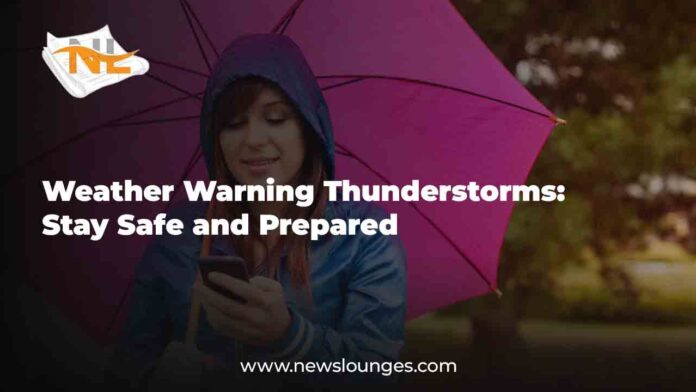Weather Warning Thunderstorms: Stay Safe and Prepared
Thunderstorms can be beautiful to watch — flashes of lightning streaking across the sky, the rumble of thunder echoing through the air. But make no mistake — when you hear the words weather warning thunderstorms, it’s not just about bad weather. It’s a signal that it’s time to act fast and stay safe.
In this guide, we’ll walk you through everything you need to know about thunderstorm warnings, from understanding what they mean to step-by-step safety tips — and even the products that can protect you and your family.
⚡ What Does a Weather Warning Thunderstorms Mean?
A weather warning for thunderstorms is issued by local weather agencies like the National Weather Service (NWS) when severe thunderstorms are expected in your area. This isn’t just about rain — it means there’s a real risk of:
-
Strong, damaging winds
-
Heavy rainfall and flash flooding
-
Hail
-
Frequent lightning
-
Even tornadoes in some cases
When a warning is announced, it means the storm is either happening now or is expected to hit soon. It’s different from a watch, which only signals the possibility.
👉 Read more about weather watches and warnings
🌩️ Why You Should Take Thunderstorm Warnings Seriously
I’ll never forget the night my family and I were caught off guard. We ignored a severe thunderstorm warning thinking it would just pass like the others. But 20 minutes later, trees were snapping outside, our power went out, and water started flooding the basement. It was terrifying.
Don’t make that mistake.
Thunderstorms can be deadly. In fact, lightning strikes kill around 20 people every year in the U.S. alone. And many more suffer injuries or property damage.
So when you see a weather warning thunderstorms alert pop up on your phone or TV, don’t shrug it off.

🧠 Understanding the Different Storm Alerts
Here’s a quick breakdown of the alerts you might hear and what they really mean:
| Alert Type | What It Means |
|---|---|
| Thunderstorm Watch | Conditions are right for a storm. Stay alert. |
| Thunderstorm Warning | A storm is happening or about to happen. Take cover now. |
| Severe Thunderstorm Warning | A dangerous storm with strong winds or large hail is coming. Take immediate action. |
👉 More on NWS storm alert system
✅ Step-by-Step: What To Do When a Weather Warning Thunderstorms Is Issued
If you’ve just received a thunderstorm warning, here’s what to do — step-by-step.
1. Get Inside Immediately
Whether you’re out shopping, walking the dog, or driving — get indoors. Thunderstorms can escalate quickly, and being outdoors puts you at serious risk.
👉 Why sheltering indoors is crucial
2. Unplug Electronics
Lightning can send dangerous surges through your wiring. Turn off and unplug:
-
TVs
-
Computers
-
Chargers
-
Appliances
Better yet — invest in a surge protector like this reliable option to prevent expensive damage.
3. Avoid Plumbing and Water
Yes, it sounds strange — but water conducts electricity. Stay away from:
-
Sinks
-
Bathtubs
-
Showers
👉 Lightning and plumbing safety tips
4. Stay Away from Windows
Strong winds and hail can shatter glass. Head to an interior room with no windows — like a bathroom, hallway, or basement.
If tornadoes are a concern, go to the lowest floor and protect your head with a blanket or helmet.
5. Use a Weather App or Radio
Stay updated with a NOAA weather radio or an app like The Weather Channel. These give you real-time alerts and radar maps.
👉 Top-rated emergency weather radios
🛡️ Smart Products to Protect You During Thunderstorms
When preparing for thunderstorms, here are some life-saving and practical products to keep on hand:
🔦 LED Emergency Flashlights
When the power goes out, you don’t want to fumble in the dark. Look for:
-
Long battery life
-
Water resistance
-
Hands-free options
👉 Highly rated emergency flashlight
🧯 Backup Power Banks
Charge your phone, flashlight, and even small medical devices.
👉 Top pick power banks for emergencies
🧰 Home Emergency Kit
Your kit should include:
-
First aid supplies
-
Bottled water
-
Non-perishable food
-
Extra batteries
-
Blankets
👉 What should go in your emergency kit?
💬 Real People, Real Stories: Why Preparedness Matters
Carlos from Texas:
“We had a weather warning thunderstorms alert, and I didn’t think much of it. That night, a tree crashed into our garage. If I hadn’t moved the car earlier, we’d have lost it. Now I always check alerts and take them seriously.”
Amy in Florida:
“My mom always made us go to the basement during storms. As a teen, I thought it was silly. But last year, lightning hit our neighbor’s house. It caught fire. That basement trip saved us.”
These are just two examples — but there are thousands of stories like them. Yours doesn’t have to be one.
🌧️ What to Do After the Storm
The storm may have passed, but the danger isn’t over. Here’s what to do:
1. Check for Damage Safely
Look for:
-
Downed power lines (stay far away!)
-
Flooding
-
Damaged roofs or trees
2. Avoid Flood Water
It can be contaminated or hide sharp debris. Don’t try to drive through it — even shallow water can sweep a car away.
3. Document Damage for Insurance
Take pictures or videos of any property damage. Contact your insurance provider as soon as possible.
👉 Filing storm damage insurance claims
💡 Final Thoughts: Don’t Wait. Get Ready.
The next time you hear weather warning thunderstorms, don’t think of it as just “bad weather.” Think of it as your early warning to protect your family and your property.
You can’t control the storm, but you can control how prepared you are.
Start by:
-
Downloading a trusted weather app
-
Assembling an emergency kit
-
Keeping a surge protector, flashlight, and power bank close
Taking these small steps can make a huge difference — and even save lives.
⭐ Buy With Confidence: Recommended Products for Thunderstorm Safety
To help you prepare, here are hand-picked essentials that thousands trust:
Buy now, so you’re not caught off guard later.
Stay smart. Stay safe. Thunderstorms don’t wait — and neither should you.
read more: https://newslounges.com/china-trade-deal-a-complete-guide-to-understand-and-profit-from-it/










